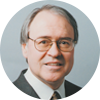Perhaps a profession has "arrived" when it is the object of humor on a popular television show. Chiropractic was the subject of an episode of The Simpsons in January 2001. Homer Simpson, the show's protagonist, hurt his lower back and went to a chiropractor. But this chatty DC prompted Homer to insist on immediate attention: "Less yakkin'; more crackin'" was his directive. This led to Homer fixing the entire neighborhood's spinal problems by pushing them backward over a barrel. But then, annoyed by the "competition," a small cadre of chiropractors in dark suits and sunglasses showed up and took Homer's barrel away.*
In the 1950s and early 1960s, chiropractors probably wouldn't have been laughing. Organized medicine (the AMA), at the height of its power, was bent on putting chiropractic out of business. I have not seen the text quoted in a long time, but every chiropractic student should read In the Public Interest by William Trevor. This book includes actual documents from the secret files of the AMA's Committee on Quackery, which was dedicated to the elimination of chiropractic in the early 1960s. At least they weren't lynching, branding or dragging us behind pickup trucks.
So - we weren't perfect. The profession, in those days, was even more poorly defined than it is today. In 1963, Sam Homola, DC, wrote a book called Bonesetting, Chiropractic, and Cultism, which was a "tell all" book emphasizing the negatives and craziness of chiropractic. It disturbed me greatly when I was a student, since I knew much of the information in the book was true. But that was no excuse for the AMA witch-hunt, based mainly on the quest for total control of the American healing arts.
I grew up in a chiropractic family. My dad was an "orthodox" DC (class of 1947) who told me that all disease was due to the top vertebra in my neck being out of place. Today, that sounds goofy, but it was among some of the chiropractic theories in existence then, many of which we would all like to forget. We chiropractors seem to be innovative, entrepreneurial and individualistic. So, with the wheat comes the chaff; with the stellar DC comes "Tarzan the DC," thumping his chest.
What isn't talked about enough in our world is the evolution of our adjusting and hands-on techniques. It is fortunate that our detractors never focused on our techniques, which have been entertaining for ourselves and perhaps our patients, but no one else. For instance, whatever happened to the "toggle recoil?" It is taught in some schools, but few DCs seem to use it in practice. Watching the thrust on the neck, even with such deft skill, is much like watching a Heimlich maneuver gone wrong. It looks like a desperate attempt to dislodge a fish bone caught in the throat.
Even more racy is the Basic Technique, whereby the practitioner applies pressure with the thumb close to "touchy spots" near the coccyx. It always seemed to me like the story of the Dutch Boy putting his finger in a hole in the dike. The biggest problem with this technique is for the DC not to fall asleep while applying it.
And of course, there are reflex techniques, visceral contact stuff, mechanically assisted gadgets, techniques critically dependent on X-rays, and so forth. At least today, we can talk. Years ago, a chiropractor's technique was like his or her signature: Don't mess with Texas, and don't mess with a chiropractor's technique. The reason I bring all this up is to note the change in our willingness to research what we do. The annual Research Agenda Conference, sponsored by the National Institutes of Health, is something that was not even imaged among the pages of DC 20 years ago. And this was brought about by chiropractic action, not philosophical yammering: less yakkin' and more crackin'!
Many positive things have happened to our profession during the past two decades. Yes, of course, some challenges are even greater today, in several arenas, such as insufficient reimbursement and student loan terror. But please remember that chiropractic care was not covered in any significant amount by insurance in those days. Cash was it. Chiropractic survived.
I regret that some of my chiropractic heroes never lived to see the favorable resolution of Wilk v the AMA. I regret they never got to see the inclusion of DCs on military bases and at veterans hospitals; a DC treating legislators in the nation's capitol; DCs in hospital ERs; DCs on Olympic medical staffs; DCs in HMO and specialty care clinics; or DCs simply receiving more referrals from MDs.
I especially regret that Joseph Janse, DC, the "Great Educator" and the president of the National College (my alma mater), never got to see it all happen. To quote him - the mentor to many of us: "Thank God a man can grow."
Yes, thank God chiropractic could grow. And Dynamic Chiropractic has been the best source for "keeping up" with this growth. Stay tuned.
- Editor's note: Some of the dialogue from the Simpson's episode referred to can be found at www.chiroweb.com/archives/19/05/06.html.
Denver, Colorado
Click here for more information about John Hanks, DC.





